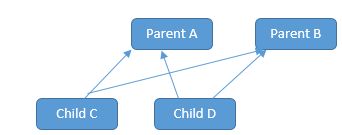Traditionally, the parent-child relationship in a work hierarchy is formed in a “one parent-many children” format. In this format, a parent work or a card in Kanban terminology can have many child tasks or child cards, but a child card can’t have more than one parent card. In SwiftKanban, we already can build such a parent-child card hierarchy that may belong to the same Board or a different one.
This capability facilitates you to build the card hierarchy on the Board, or build the same using a Microsoft© Excel-based template and then importing back to SwiftKanban. Additionally, you can quickly build the hierarchy among many cards by using the Batch Update or the Bulk Edit feature.
Now, with the changed business scenario, you may have a requirement where the work done in a child card may have an impact on multiple parent cards, hence the child card needs to be linked to all of them. To fulfill such a requirement, we have a licensed feature that lets you link a child card to many parent cards and build a multi parent-child card hierarchy.
Let us understand it in detail.
Acquiring a License for the Multi-Parent
The Multi-parent feature is only available with SwiftKanban Enterprise License. If you are a SwiftKanban Team or Group License subscriber and would like to use the Multi-parent feature, you will need to upgrade to the SwiftKanban Enterprise License. For more information on the pricing, please refer to this page. To avail of the Enterprise License, please contact us at [email protected].
Creating Multi Parent-Child Card Hierarchy
Once you have enabled the license, you are now ready to create the Multi Parent-Child Card Hierarchy. Read the “Linking existing cards across boards” section on this page to know how to build such a hierarchy of cards across Boards.
With this Multi-parent feature:
- You can search and link a card as a parent for a child card, which may already been defined and linked as a parent card in other parent-child hierarchy. Read here to know how to search and link a parent card.
In the above example, let’s assume we have first created a child card, Child C which already has a parent card, Parent A. Now, using the multi-parent feature, I can search for another card, Parent B, and make it the parent card of Child C. This means, Child C card simultaneously has two different parent cards, Parent A and Parent B.
Now, let us understand a few important points about the multi-parent feature:
- Both the Batch Update and Bulk Edit feature do not support the multi-parent feature. They support the single parent-child hierarchy only.
- Roll-up of estimate will not work in multi-parent. Normally, in the single parent-child hierarchy, the estimated value of the child card is automatically rolled up to its immediate parent card. So, the estimate field will be editable for the child card, but read-only for its parent card.
In the above example, Child C card has been allocated 10 story points, so it has been rolled up to its parent card, Parent B, and ultimately to Parent A.
But, in the case of multi-parent, this roll-up will not work, which means the story point in Child C will not be rolled up to Parent B and subsequently to Parent A. Moreover, in this case, the estimation will be editable for both the child and parent cards. So, you not only need to enter the estimate of Child C but also manually enter the rolled-up estimate for Parent B and Parent A.


